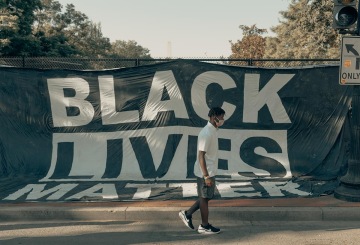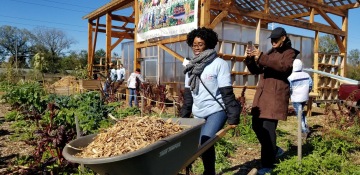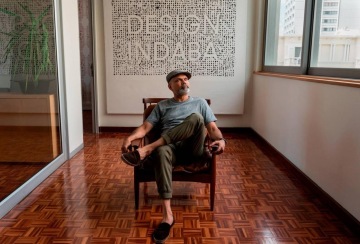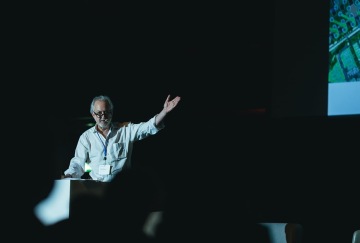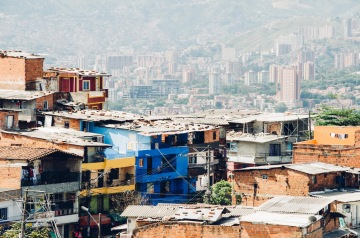
Eight Talks on Using Design to Solve Urban Inequalities
Can design be used to solve urban inequalities? Hear eight talks from reSITE speakers with examples on how we can use the built environment as a tool for social impact.
Notions of architects as larger-than-life figures with the ability to reorder the world around themselves are often contemporarily thought of in terms of ‘starchitects’, but go back as far as Frank Lloyd Wright, whose plan for Broadacre City included a top-floor office for the region’s architect to observe and design from. This rather authoritarian notion of the city was not necessarily out of place in an age where theorists like Le Corbusier often diagnosed urban problems with medical terminology, describing different types of cities as ‘organs’.
If we are to look past the lens of top-down planning, or medical diagnosis that often implicates poor and racial minorities, where does that leave the role of the architect or urban designer in working to solve urban inequalities?
Whatever role that urban design can play in mitigating urban inequalities must arise from the bottom up: a grassroots approach. We've compiled a list of eight memorable reSITE lectures that demonstrate the impact design can have on social change.
There Grows the Neighborhood with Emmanuel Pratt
Emmanuel Pratt’s, co-founder of the Sweet Water Foundation, focus on grassroots community development through urban ecology has planted seeds of transformation in Chicago neighborhoods. The community-building that the Foundation has been able to accomplish by using their own urban environment to provide for the community through collective action. Pratt’s philosophy of focusing on what the community can do as a whole for the whole — rather than for the individual.
Alfredo Brillembourg on How We Should Tackle Urban Poverty
The residesign of unoccupied urban space for the benefit of the community is necessary in order to sustain successful public housing projects, as explained by Alfredo Brillembourg, co-founder of Urban-Think Tank. Brillembourg notes that it is not the design of public housing itself that fails—as has been previously debunked in the Pruitt-Igoe Myth—but the failure of planners and the state to provide anything in addition to housing.
While much of his work focuses on Caracas, he also cites examples from Prague and Paris in order to demonstrate how planning failures such as an abundance of green space and lack of jobs can be detrimental to those living in public housing. Ultimately, this leads to justifiable frustration on behalf of residents and offers little to no opportunity for socioeconomic mobility.
Leona Lynen on the Collaborative Regeneration of Haus der Statistik
Leona Lynen is a working memeber of the cooperative, ZUsammenKUNFT Berlin. The organization is working to incorporate Berlin’s Haus der Statistik into a service for the city, speaks on the potential for partnership between the state and civil society in a project that is focused on serving the community rather than being a source of gentrification. The former DDR statistical office, the site had become a notable empty space located just off of Alexanderplatz.
Through urban interventions and public demonstrations,Lynen explains how the building became a site of public interest, with demands for its future plans to serve the community rather than become another apartment or business complex in a centrally located area. Thus, they are working in partnership with the government to turn the building into a cultural and educational space that is community-facing.
How To End Segregation through Spatial Integration with SLLA Architects
If we are to approach the question of urban inequalities from the scale of the urban, we must also approach it on the scale of the building, argues Michal Sulo of SLAA Architects. The design of buildings that welcome foot traffic, rather than being car-centric—which is not only environmentally disastrous but also reinforces racial profiling in policing—is a potential start. In response to anti-Roma interactions in České Budějovice, SLLA’s Community Center Maj offers a potential space to serve state-offered public needs in a massive public housing site.
Enrique Peñalosa on Why Equality Begins with Well-Planned Public Spaces
In order to create equitable urban spaces, citizens ability to move freely and safely throughout the city is paramount. Enrique Peñalosa, the former Mayor of Bogota, Colombia discusses the important of learning from the disastrous mistakes of 20th-century urbanization. By choosing to focus on pedestrian and bicycle highways instead of expanding highway systems, we can create cities that are both inclusive to vulnerable citizens and invite people to connect with nature and intrinsically safer and healthier.
Why Inclusive Design Matters
Charlot Schans’ work at Pakhuis de Zwijger, Amsterdam, has sought to provide opportunities for the adaptation of unoccupied public space into an educational forum for more inclusive immigration in a city that has ugly marks of segregation. By adapting their space for design sessions, public presentations, movie screenings, and various other events, Pakhuis de Zwijger has demonstrated how variated reuse of a space can challenge urban segregation.
Teddy Cruz on Rethinking Border Zones As Potential For Political Creativity
Similarly, the work of Teddy Cruz focuses on how we can adapt existing spaces to meet the challenges of urban inequality. Focusing on border areas, specifically the urban agglomeration of San Diego-Tijuana — separated by the U.S.-Mexico border wall — exemplifies a site that is both environmentally and socially disruptive. The wall separates two communities, that are, as Cruz explains, are socially, economically, and environmentally intertwined.
Cruz notes that the political aspects of the site make the challenges of adapting the urban environment different, but through his work, has sought to not only expose inequalities but challenge the divide of the political border that can be seen as very harsh from those who do not live within the communities of San Diego-Tijuana. Through an agreement with Mexican immigration officials, Cruz was able to negotiate a 24-hour border crossing via a drainage pipe between San Diego and Tijuana, shows not only the porous nature of the border, but invites us to reimagine a future border that does not serve to perpetuate the inequalities that exist between the urban areas on each side of the border.
Ravi Naidoo on Creating a Better World Through Creativity
Ravi Naidoo is a South African pioneer design practitioner. He is best known for founding Design Indaba, as he calls it - a "think-tank, do-tank". During his presentation he uses example activations of design for impact while challenging the audience to question the purpose of design.
He believes that design can be the ultimate toolkit to reimagine future cities with the power to enhance democracy, elevate cultural identity, improve the quality of life, and act in the service of people. By creating solutions that foster environmental, social, and economic change he believes in creating a better world through that kind of creativity.
If urban design wants to seriously challenge itself to go beyond aesthetics and rethink itself to take on resolving urban inequalities, it must seek to design from the bottom-up. As successful as larger, public projects can be, they must be done with the cognizance of their impact on communities that are already struggling to access urban spaces or are being displaced. This does not mean that aesthetics should be tossed aside, but that successful challenges to existing inequalities cannot only exist with only design appeal in mind.
More ideas on using design to solve urban inequalities
Systemic Racism is by Design
We’ve taken a backseat to listen and to reflect on ways we have been complicit in institutional racism, and how we can implement more inclusive anti-racist actions. Photo by Clay Banks.
Emmanuel Pratt on Regenerating Urban Ecology
Emmanuel Pratt, MacArthur fellow and founder of Sweet Water Foundation, regenerates neighborhoods by fusing architecture & community development.
Giving Design a Higher Purpose with Ravi Naidoo
Ravi Naidoo, the driving force behind Design Indaba, arguably the most influential design event in the world. The event takes place annually in Cape Town is only the tip of the iceberg. Listen as he pushes the boundaries of the purpose design holds with the simple question—what is design for? Photo courtesy of Design Indaba
Remembering a Bright Urbanist Mind: Michael Sorkin
Late Michael Sorkin, the architectural critic, author, professor and designer, leaves behind his revolutionary approaches to urban design. We pay him a tribute in this look at how his legacy will continue to influence the field of urbanism for years to come. Photo courtesy of Dorota Velek at reSITE 2015.
